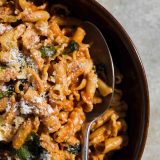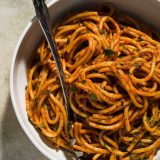Trying to persuade anemic winter tomatoes to produce a pasta sauce with big, fresh flavors typically is a lost cause. In fact, in our Milk Street Cooking School classes we urge our students to not even try. Instead, we focus on the wonderful sauces that can be created by starting with an ingredient that comes to the kitchen already jammed with flavor: tomato paste.
Thanks to a few easy flavor-boosting techniques, turning those tiny cans into something shockingly good takes just minutes. It’s a great example of how delicious your cooking can be when you let your ingredients do the work for you.
We start building richness into the foundation for the sauce by gently frying thinly sliced garlic cloves in a bit of olive oil. This also mellows the acridness of raw garlic. We opted to keep the seasoning simple, adding just a little dried basil to the oil with the garlic. But this recipe is an easily adapted template. Add seasonings as you see fit, including whole spices such as coriander, fennel and cumin seeds.
Next, to draw even more flavor from the already umami-rich tomato paste, we brown it deeply. When browned, it becomes incredibly savory and rich, adding more depth to the toasted garlic base. To this we add a bit of fresh basil, allowing it to infuse and lighten the rich tomato paste. We double down on the herbal flavor by finishing the dish with yet more basil later, which keeps the flavors fresh. The result is layers of different, yet complementary flavors.
Finally, the pasta. We undercook our pasta, draining it (and saving some of the cooking water) when it is shy of al dente. This allows us to finish cooking it in the sauce, thereby absorbing flavor as well as water. The reserved starchy cooking water is used to thin the browned tomato paste into a loose-but-clingy sauce that can coat the noodles evenly. The result: more flavorful noodles and a perfect toothsome texture.








